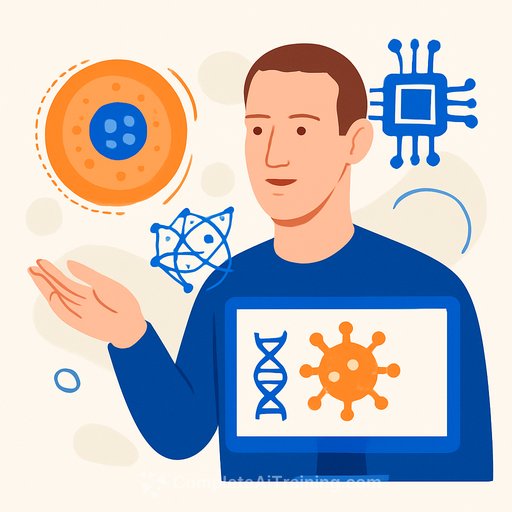AI Meets Biology: Zuckerberg's New Push to Fast-Track Disease Research
Mark Zuckerberg announced a new direction for the Chan Zuckerberg Initiative (CZI): integrating artificial intelligence with biology to help scientists cure diseases. The first step is a Biohub focused on building "virtual cells" and "virtual immune systems" using large-scale compute and the largest human cell data sets available.
"We are bringing together leading AI researchers, scientists, massive computer clusters, and the largest human cell data sets to create virtual cells and virtual immune systems to help advance science," he said on Facebook. For researchers, this points to deeper in silico experimentation backed by serious infrastructure.
What Virtual Cells Could Mean for Your Work
- In silico perturbation: Run simulated knockouts/knockdowns and pathway edits before committing wet-lab budget.
- Cell-state modeling: Track transitions, fate decisions, and response curves across time and environment.
- Variant effect prediction: Prioritize targets and variants with ML-driven impact scoring.
- Immune dynamics: Model antigen recognition, repertoire shifts, and cytokine signaling under different stimuli.
- Design loops: Close the gap between model suggestions and bench validation with tighter experiment-compute cycles.
Data, Compute, and the Biohub Lens
The initiative centers on scale: large model training, multimodal biological data, and standardized pipelines. Expect emphasis on high-quality single-cell atlases, imaging-derived features, and consistent metadata for reproducibility.
If this effort connects to existing open assets, it could amplify resources like single-cell portals and atlas initiatives. For context on networked biohubs, see the CZI Biohub Network overview.
Meta's Broader AI Posture
Meta Platforms said it plans to invest $600 billion in the US over the next three years, citing AI data centers, jobs, and infrastructure. The company also disclosed layoffs of 600 workers in its AI unit in October.
For labs and institutes, this mix of spend and restructuring means two things: more AI infrastructure build-out, and a moving talent landscape. Partnerships, credits, and access programs may shift quickly-keep an eye on procurement and collaboration channels.
Practical Next Steps for Research Teams
- Map your data flow: Where are your single-cell, proteomics, imaging, and EHR datasets? Are schemas and metadata consistent?
- Prep governance: Refresh IRB protocols, data-use agreements, and model audit trails for AI-driven analyses.
- Budget for compute: Estimate training vs. inference costs; plan for hybrid setups (on-prem + cloud) and spot-price volatility.
- Upskill fast: Build a core stack-foundational ML for biology, causal inference basics, and generative modeling for sequences and structures.
- Prioritize interpretability: Choose methods with clear attribution maps, uncertainty estimates, and reproducible pipelines.
- Pilot in silico first: Use small, well-scoped virtual experiments to de-risk wet-lab runs and refine protocols.
Why This Matters
Virtual cells and simulated immune systems can compress timelines for hypothesis testing and target validation. If CZI delivers shared tools and data access, more labs can run credible in silico screens without building everything from scratch.
The upside is faster iteration; the constraint is quality-data curation, model validation, and tight loop closure with the bench will decide real impact.
Resources
- Explore the CZI Biohub Network: czbiohub.org
- Skill up your team with role-focused AI learning paths: Complete AI Training - Courses by Job
Bottom line: watch for public datasets, toolkits, and partnership announcements from CZI. Line up your data, set clear evaluation criteria, and be ready to plug into virtual experiments the moment they open up.
Your membership also unlocks:






